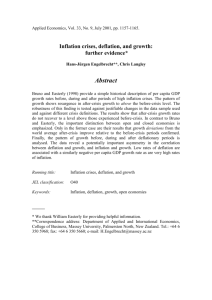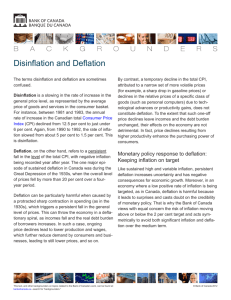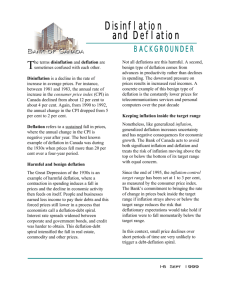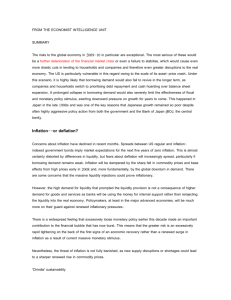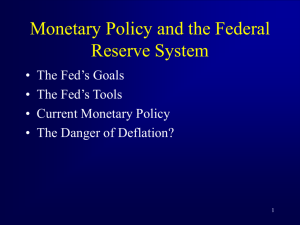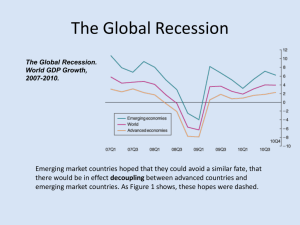Deflation: Threat to Global Prosperity? For the third straight year, the
advertisement
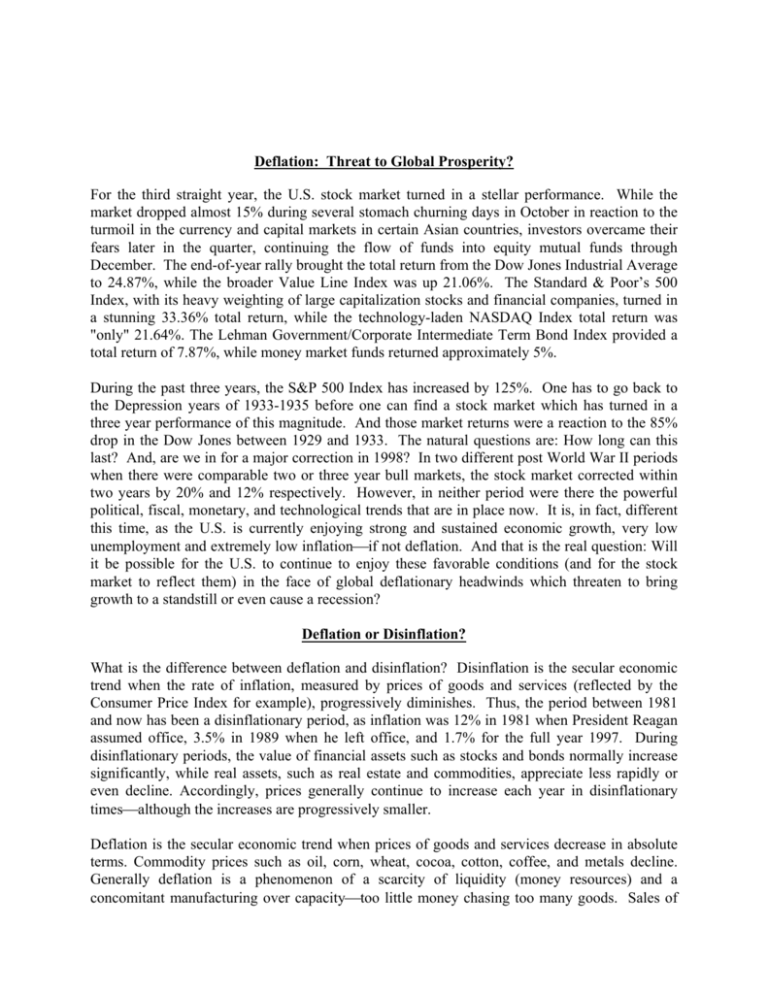
Deflation: Threat to Global Prosperity? For the third straight year, the U.S. stock market turned in a stellar performance. While the market dropped almost 15% during several stomach churning days in October in reaction to the turmoil in the currency and capital markets in certain Asian countries, investors overcame their fears later in the quarter, continuing the flow of funds into equity mutual funds through December. The end-of-year rally brought the total return from the Dow Jones Industrial Average to 24.87%, while the broader Value Line Index was up 21.06%. The Standard & Poor’s 500 Index, with its heavy weighting of large capitalization stocks and financial companies, turned in a stunning 33.36% total return, while the technology-laden NASDAQ Index total return was "only" 21.64%. The Lehman Government/Corporate Intermediate Term Bond Index provided a total return of 7.87%, while money market funds returned approximately 5%. During the past three years, the S&P 500 Index has increased by 125%. One has to go back to the Depression years of 1933-1935 before one can find a stock market which has turned in a three year performance of this magnitude. And those market returns were a reaction to the 85% drop in the Dow Jones between 1929 and 1933. The natural questions are: How long can this last? And, are we in for a major correction in 1998? In two different post World War II periods when there were comparable two or three year bull markets, the stock market corrected within two years by 20% and 12% respectively. However, in neither period were there the powerful political, fiscal, monetary, and technological trends that are in place now. It is, in fact, different this time, as the U.S. is currently enjoying strong and sustained economic growth, very low unemployment and extremely low inflationif not deflation. And that is the real question: Will it be possible for the U.S. to continue to enjoy these favorable conditions (and for the stock market to reflect them) in the face of global deflationary headwinds which threaten to bring growth to a standstill or even cause a recession? Deflation or Disinflation? What is the difference between deflation and disinflation? Disinflation is the secular economic trend when the rate of inflation, measured by prices of goods and services (reflected by the Consumer Price Index for example), progressively diminishes. Thus, the period between 1981 and now has been a disinflationary period, as inflation was 12% in 1981 when President Reagan assumed office, 3.5% in 1989 when he left office, and 1.7% for the full year 1997. During disinflationary periods, the value of financial assets such as stocks and bonds normally increase significantly, while real assets, such as real estate and commodities, appreciate less rapidly or even decline. Accordingly, prices generally continue to increase each year in disinflationary timesalthough the increases are progressively smaller. Deflation is the secular economic trend when prices of goods and services decrease in absolute terms. Commodity prices such as oil, corn, wheat, cocoa, cotton, coffee, and metals decline. Generally deflation is a phenomenon of a scarcity of liquidity (money resources) and a concomitant manufacturing over capacitytoo little money chasing too many goods. Sales of houses, cars, and consumer durables fall, commodity prices turn downward, economic growth stagnates or recedes, and a deflationary spiral can result. A deflationary spiral can be even more destructive than an inflationary spiral, as was seen in the Depression in the 1930’s in the U.S. when unemployment reached 25% and fascism took root in Europe. Falling prices usually mean lower corporate operating margins, which squeeze profits, often causing firms to cut employment. As a result, employees have less money for goods and services, causing prices to drop further and corporate earnings to decrease even more. Borrowers are unable to service their debt, causing loan and mortgage defaults, which can threaten the stability of banks and even the entire banking system. In politically unstable countries, deflationary spirals can cause deep social problems which can threaten democratically elected governments. During 1997, wholesale prices (as charted by the Producer Price Index) actually dropped 1.2%. Inflation, as measured by the Consumer Price Index (CPI), increased only 1.7%the smallest annual gain since the Department of Labor first began collecting data in 1974. The Boskin Commission last year concluded that the CPI overstates inflation by 1% - 2% so that 1997 was, in all likelihood, a year of price equilibrium in the U.S. The recent currency and stock market troubles in Asia have unleashed powerful deflationary impulses in the global economy, and some observers believe that the economic contraction underway in Asia and in parts of Latin America will only amplify it. The current price of gold seems to confirm that deflationary impulses (rather than disinflation) are gaining the upper hand and that the fight against inflation has largely been won for now. Is Gold the Best Indicator of Price Trends? In the early 1970’s, one of the Principals of Bradley, Foster & Sargent, Inc. was working for Citibank in South Africa when the gold price was approximately $40 an ounce, having been adjusted by President Nixon from the $35 an ounce set by President Roosevelt in the 1930’s. During that period, Citibank was in the forefront of those saying that gold no longer had a role as a monetary asset and that it was merely a commodity whose price was set by supply and demand. According to Citibank, gold would soon be a “barbarous relic”decoupled from its historic role through centuries as the primary monetary asset and store of value for its holders. During the next several years when the U.S. completely abandoned its 1944 pledge at Bretton Woods to maintain the price of gold at $35 per ounce, the dollar price of gold floated to $140 by 1973. The worst inflation in the U.S. history soon followed, suggesting that gold once again could be a good leading indicator of price inflation or deflation. According to well known supply-side author Jude Wanniski, gold’s critical function is to provide the Federal Reserve, which has the vital job of determining how much money to create from dayto-day, with a precise signal of demand for money. This theory holds that when the price of gold is rising or soars such as in the late 1970’s and in 1980 when it briefly hit $850 an ounce, it is a clear signal that there is too much liquiditythat the Fed has created an excessive amount of money. To absorb money, the Fed needs to sell bonds from its portfolio for cash and bank reserves that pay no interest. When the price of gold is falling dramatically as it is nowover 25% to $280 an ounce over the past year, it is a sign that there is not enough liquidity in the system. This can lead to deflation. For monetarists, the difficult question is what is the optimum price of gold in dollars at any given time. Depending upon the answer to that question, one concludes whether the Fed should be creating liquidity to ensure no global deflation occurs or sopping it up to ensure that an inflationary spiral does not re-commence. According to Jack Kemp and other supply-siders, the price of gold should be $350, which will create price equilibrium and disadvantage neither debtors nor creditors. In a recent issue of The Wall Street Journal, the editorial board called for the Federal Reserve Bank to provide enough global liquidity to ensure that deflation doesn’t occur by maintaining a floor on the price of gold of $300, committing to buy gold for dollars at $300 an ounce. Other economists and observers do not ascribe to gold such a key position in the international monetary system. Many believe that the Fed should watch a whole basket of commodities including oil, food, metals, gold, and others as an indication of price trends. One of the hardest problems to solve for the Fed is to track the monetary aggregates and to determinate what the money supply really is and how fast it is growing. With dollar liquidity increasingly used as means of exchange in many lesser developed countries and with the huge Euro-dollar aggregates held abroad, it is exceedingly difficult for the Fed to gauge the proper creation of money supply. Thankfully, the Fed has other instruments of monetary policy at its disposal such as open market activities and raising and lowering the discount rate and the Fed funds rate, which can help create liquidity and raise economic activity. A good example of this was during the S&L and banking crisis in the U.S. in 1991-1993 when the Fed helped provide liquidity to the system by bringing short-term interest rates to 3%. There are also fiscal and political measures that can be taken to help prevent a deflation, chief among these being lower tariffs to encourage global trade, lower taxes to foster more investment and more consumption, and de-regulation so that consumers have more money to spend. 1998 Forecast At Bradley, Foster & Sargent, Inc. we believe that the price of gold is, indeed, a good indicator that global deflationary forces are real and that they are potentially threatening for the U. S. economy. The U.S. economy is increasingly linked to the economies of other regions, and what occurs in Asia, Europe and Latin America will have an effect on the U.S. economy and our corporate profits. The Asian GDP as a percentage of global GDP is 28%, and if Asian GDP growth falls from 7-8% in the first half of the 1990’s to zero or even a serious decline, this will surely have consequences on the U.S. economy. However, the U.S. economy is firing on all cylinders in some of the best conditions of this century, and Europe, which is considerably more important to U.S. corporate profitability than Asia, is beginning to re-accelerate its growthin spite of economic sluggishness in France and Germany. Our forecast is that the engine of U.S. economic growth plus the better outlook for the European economy, as well as appropriate deflation fighting steps by the Fed and other monetary authorities, will combine to overcome the forces of deflation that are threatening. It is important to reiterate the reasons for this remarkable engine of U.S. economic growth over the past decade and a half. They are: dramatically lower income and capital gains taxes, sound monetary policy fostering price stability and a strong dollar, a commitment to lowering protective tariffs and increasing global trade, the end of the Cold War brought about by a strong defense, an outbreak of democratic capitalism around the world, a commitment to deregulation to benefit consumers, and a technological revolution engendered by significant capital spending and strong corporate cash flow. These are powerful trends, and a trend, once in motion, is not easily reversed. We also believe that the Fed will shift its focus this year from inflation fighting to deflation fighting and will lower short-term interest rates to ensure that more liquidity enters into the global economy. Accordingly, we believe that the U.S. economy will continue to grow in 1998perhaps at 2.5%, which is down from 3.7% in 1997and that this growth will do much to counter the global deflationary forces. We believe that corporate profit margins will stay high and that corporate earnings will grow at 7-8% this year. What Does This Mean for the Stock Market Lower interest rates in the U.S. should mean that the stock market will value corporate earnings at a higher multiple. Consequently, although corporate earnings growth may be lower than originally forecast in the U.S., ($48 for the S&P 500 Index earnings for 1998 rather than the $50 which was the consensus earnings forecast several months ago), the stock market may well value these earnings at a higher price/earnings ratio. By mid-year 1998, the stock market will begin to focus on 1999’s earnings, which we estimate at $51 for the S&P 500. With inflation at close to zero, a P/E multiple of 20 or more would not be out of line, so it is quite possible that the S&P 500 Index will break 1,000 this year and perhaps rise to 1,050. If the stock market were to hit 1,050 during the course of 1998, this would translate into a 8-10% gain this year, a more modest return than in the recent past. There are obviously many events which can happen to invalidate this forecast and cause a serious correction, but this is our best guess at this time. What is significant is that in spite of a dramatic performance over the past three years, the stock market is reasonably valued, given the near zero rate of inflation and continued good GDP growth which should translate into growing corporate earnings. In the absence of serious overvaluation and with the powerful trends in place in the U.S., we are cautiously optimistic. Accordingly, we will continue to seek to purchase, at good prices, high quality growth companies. We also are more positive about the prospects of intermediate and longer term bonds than we have been in some years, due to the possibility of lower interest rates. © Bradley, Foster & Sargent, Inc. January 1998

